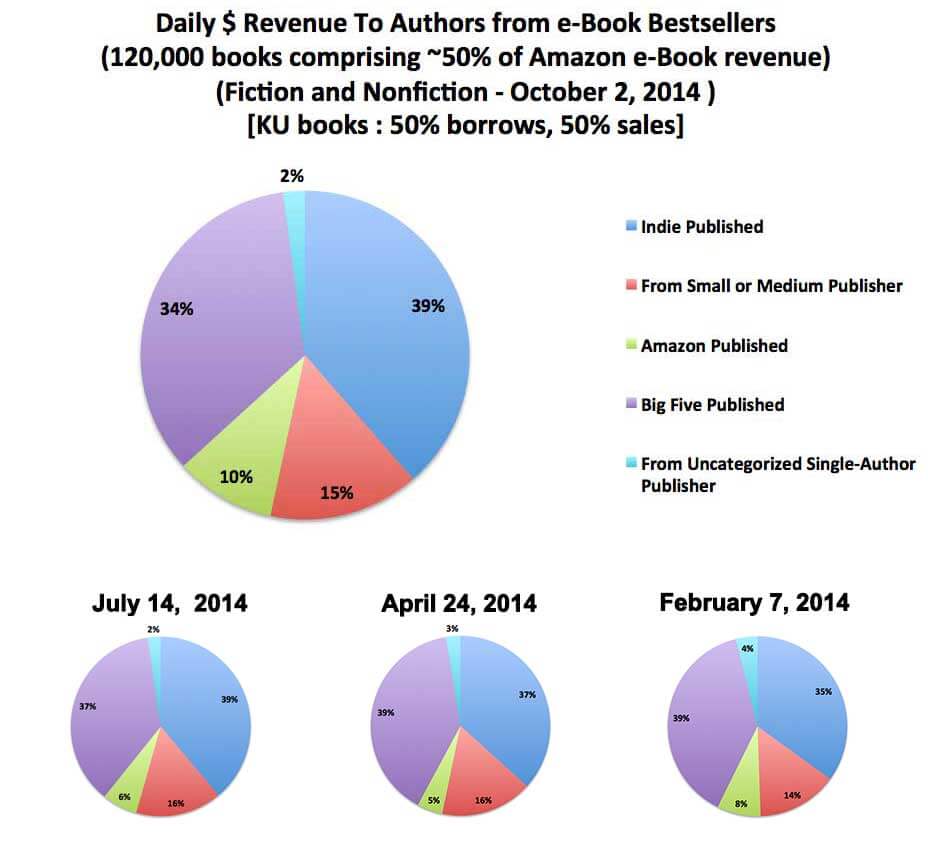 AuthorEarnings.com has released its quarterly look at Amazon ebook sales and author earnings. As with previous reports, the data takes a hard look at projected sales and author earnings by pulling data for over 120,000 ebooks off Amazon’s product pages.
AuthorEarnings.com has released its quarterly look at Amazon ebook sales and author earnings. As with previous reports, the data takes a hard look at projected sales and author earnings by pulling data for over 120,000 ebooks off Amazon’s product pages.
Using known rank-to-sales rates, they are able to estimate the daily share of earnings by publishing path. The goal is to provide a deeper understanding of the ebook market than is afforded by reporting from major publishers or by tracking ISBNs, which many self-published authors do not use. Amazon, with an estimated 60%+ of the ebook market, is used as the focus of the report.
Example of the info included:
And, according to AuthorEarnings.com:
What the data tells us, then, is that self-publishing is just as viable as any other form of publishing. Perhaps more so. No one can halt your career because an early title underperforms expectations. You get to hire the editors and cover artists you want to work with. You get to write whatever you want and publish whenever and however often you like. And you can publish every which way. Self-publishing used to close you off to other avenues, now it simply opens them up. Many authors publish in several ways simultaneously.
Every author will need to find their own path. There is no one right answer. If there’s anything the data tells us, it’s that readers are starving for great stories at fair prices, and whoever can deliver that consistently has a chance at earning income doing something they love. Maybe not a great chance at earning a full-time living, but a better chance than at any other time in human history. And that must be celebrated, however you crunch the numbers.
To view the entire report, including a download of raw data used and several insightful comments from fellow authors, visit AuthorEarnings.com. And tell us your thoughts on the findings this quarter!


Great article and very informative. And it’s definitely true that you need to have a good sense of what your target audience feels comfortable with. My elderly aunt, for instance, is a voracious reader but continues to be skeptical about those new-fangled electronic books. In fact, whenever I finish reading a novel and tell her about it, she always asks, “Was it a REAL book, dear, or one of those fake ones?” In my view, every book is real regardless of the platform in which it is published. It’s real because of the real time and energy an author put into it in order to put it on the market for other real people to be entertained, educated or inspired by.
Great insights, Christina! Speaking of which, we need to tell authors about YOUR latest book that will appeal to authorpreneurs 🙂
Whether we have a publisher or choose to self-publish, I think we may need to evaluate this according to what OUR own audience prefers to read. Unless we’re a NYT bestseller, we tend to have our niche. If our niche happens to prefer paperback to e-book, if we’re going to self publish, we need to go the POD route as well as offering in ebook. We can’t just assume they’ll trend toward e-book, no matter what the stats say. If we use a publisher, we need to make sure we’ve covered both. This requires us to evaluate our own stats, as compared to these pie charts.
For instance, I just received my first royalty check for my novel Refuge, which published in March. I was very surprised to find that my readers don’t follow the trend of preferring e-books. My e-book sales comprised less than 5% of my sales. I’ve also discovered that my readers buy the book and share it around to many people. This means, I should have many more sales if everyone bought their own copy (which I could try to force them to do by only releasing in e-book). But this is the preference of my particular readers. I’ve polled, surveyed, and examined them. This is how they like to do it. They will not buy e-books. They’ll just pass on by.
I’m trying to learn to adapt to the reader, rather than thinking they’ll change their habits, no matter how much I “educate” them about how that effects my ability to make a living and to write future stories. As a result, since I’m considering self publishing an off-genre book while I continue to publish my series with my publisher, I will definitely be choosing to do this with Print-on-Demand and e-book.
Great insights, Melinda! And very true that depending on the audience and content, ebooks aren’t always the be-all, end-all. (I have non-fiction books heavy on illustration — ebooks account for less than 10% of units purchased). Thanks for the input and let us know how it goes with the new book!